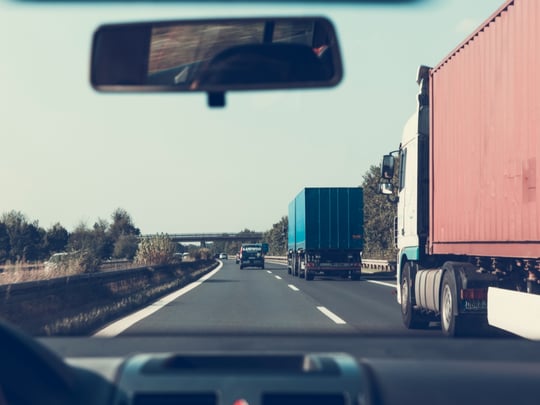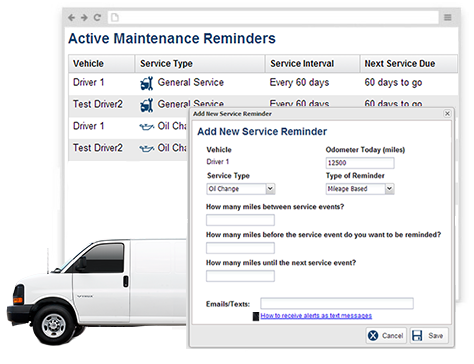Seat belts save nearly 12,000 lives and prevent 325,000 serious injuries every year. Fleet managers will agree that driver safety is paramount, but how do you maintain a safe workplace when your employees work in the field?
Fleet managers can’t keep their eyes on their employees at all times, so they often rely on GPS tracking devices to see how drivers are acting on the road. However, the key to creating a lasting culture of safety in your workplace is to formalize a fleet safety policy and clearly communicate these expectations to every employee.
Vehicle crashes cost employers $60 billion annually. The average crash costs $16,500, and that cost can reach up to $500,000 if someone is injured. Beyond increasing driver safety, fleet safety policies can also help you reduce costs and improve your fleet’s overall operations. But before we dig into how a formal fleet safety policy can help you decrease costs, earn more money, and most importantly protect your employees, let’s take a look at what a fleet safety policy really is.
What is a fleet safety policy?
Formal fleet safety programs establish the policies and procedures required to maintain a safe workplace. They do this by:
- Providing rules and guidelines for safe conduct and vehicle operations both on and off the clock.
- Outlining disciplinary procedures for unsafe driving, as well as reward programs for proven safe driving.
- Defining post-accident or collision protocol.
- Giving drivers the confidence of knowing that their employer is committed to their safety and the safety of other motorists.
Why do you need a fleet safety policy?
Fleet safety policies can help you do more than keep your drivers safe. They can also help your business save money and time while decreasing fatalities, injuries, crashes, and other asset damage, no matter how large or small your fleet is.
Here are four reasons why your business needs a formalized fleet safety policy:
1. Encouraging safe driver behavior
Did you know that alcohol is a factor in 39% of all work-related traffic crashes? You may think rules like wearing seat belts and not driving under the influence of alcohol are common sense and don’t need to be written down and formalized, but having a fleet safety policy ensures that employees know that they must follow safe practices at all times. Knowing it’s a required part of their job means they are more likely to comply, even with something as simple as buckling up or as obvious as not drinking on the job.
Linxup’s daily driver safety report cards can help you encourage safe driver behavior. Learn more about driver safety scores.
2. Reducing accident costs
Following an accident, a business can expect to pay for:
- Medical care
- Legal expenses
- Property damage
- Lost productivity
But it’s not only the obvious accident expenses you have to worry about indirect costs can also add up quickly, such as:
- Lower customer satisfaction, potentially leading to a decrease in sales.
- Downtime while hiring and training new employees, or repairing or replacing damaged vehicles and equipment.
- Time and resources required to investigate collisions and other traffic incidents.
- Media attention and its impact on your company’s public image.
- Potential lawsuits.
Creating formalized rules and policies for driver safety and communicating these expectations to your drivers helps encourage and enforce safe driving habits both on and off the clock. This can lead to fewer accidents and reduced costs in the event that a collision does occur.
3. Lower insurance costs
Having a fleet safety policy can reduce your insurance premiums because it demonstrates that you’re committed to actively pursuing a safe environment for your employees, workplace, and customers. Your fleet safety policy shows how seriously you take the security of your team by detailing the ways you will:
- Monitor drivers and vehicles for data that insurance companies value, such as mileage and driver history.
- Increase driver safety by coaching employees to improve their skills and helping them to avoid dangerous traffic situations.
- Enhance vehicle safety and security by automating maintenance and reducing costly emergency repairs.
You can further lower your insurance costs by implementing a GPS tracking system. Learn more about how GPS tracking devices can help reduce insurance premiums.
4. Improve fleet operations
A fleet safety policy is not designed simply to prevent negative things from occurring. Formal fleet safety policies add value by helping your business improve operations. They do this by:
- Reducing fuel usage by identifying opportunities to cut down on wasteful driving practices like speeding and harsh braking.
- Raising vehicle resale value and lifespan with a clearly outlined maintenance plan that will help reduce the wear and tear of daily use.
- Increasing productivity and worker well-being by expanding driving practices to include safer, smarter driving habits using a system that can help you coach employees.
GPS tracking devices make it easier to identify opportunities to reduce unsafe and wasteful behaviors, as well as increase your fleet’s overall productivity. Learn more about how GPS tracking can help improve fleet performance.
Monitoring driver safety
GPS tracking devices can enhance the success of your formalized fleet safety policy by providing the tools necessary to monitor driver safety and improve fleet operations. The data collected by GPS tracking devices makes it easy to identify patterns of unsafe behavior, while real-time alerts for events like speeding and harsh braking enable business managers to address dangerous behaviors as they happen.
GPS devices can also be used to automate vehicle maintenance, which increases the safety and security of your fleet vehicles and ensures that your drivers maintain their preventive maintenance schedule.
Safety first
Creating and implementing a formalized fleet safety policy may seem like a daunting task, but fleet safety policies provide significant benefits to your business. In addition to improving safety, they can also help you reduce costs and increase your productivity.
Find out how much GPS tracking can save your company with our ROI calculator.
Ready to learn more?
Now that you're ready to create your fleet safety policy, why stop there? Check out how to keep your drivers safe during winter conditions, and how dash cams can be used to coach (not catch) drivers.



